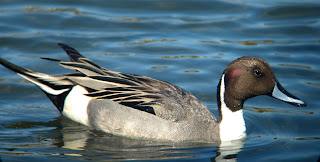Common Teal
Anas crecca
10th March 2011
Yatsu-Higata is a great place to get close to ducks and records suggest that it is in general an excellent place for birdwatching and photography. Non-birders may like it too as it has a fantastic state of the art observation centre with a restaurant and tea room and comfortable facilities; Tokyo Bay shopping mall is short walk form the station and there is also an amusement park nearby. In fact non-birders could spend the day at Tokyo Disney Resort which is a few stops before on the railway line.
Eurasian Wigeon
Anas penelope
10th March 2011
Yatsu-Higata is a tidal mudflat completely surrounded by urban life. It really is an amazing place and at the right times it will be a great place for waders too; I believe our friend Spoon-billed Sandpiper has been recorded here. There is also a small freshwater pond next to the observation centre. It is remarkably easy to reach from central Tokyo; take the Japan Rail Keiyo Line to Minami-Funabashi station, turn right out of the exit barriers and there is a board showing the way.....pretty simple, turn right out of the station , cross the road at the pedestrian bridge about 300 meters along the road, turn right again, cross the road at the lights and enter the site on the left. No more than a 10 minute walk from the station. There is a good sealed footpath making it possible to walk around the entire site. The observation centre is a further 10 - 15 minutes on from this entrance.
Northern shoveller
Anas clypeata
10th March 2011
I decided to digiscope today as the ducks were so close. However it was freezing cold so first up I had to head to the mall and get a hat, some gloves and a neck baffle. Thereafter I had a lot of fun and I split the day up with a late lunch in the observation centre: a very tasty beef curry with rice.
Greater Scaup
Aythya marila
10th March 2011
There were vast numbers of duck with Eurasian Wigeon probably being in the majority and in addition to the birds shown here there were Coot, Little Grebe, Dusky Thrush, Brown-eared Bulbul, Grey Heron, Intermediate Egret, Little Egret, Common Sandpiper, Pale Thrush, Black-winged Stilt, Common Reed Bunting, Grey Plover, a solitary Bull-headed Shrike in front of the observation centre and a very substantial flock of what I took to be Dunlin flew in about 1700h.
Black-headed Gull
Larus ridibundus
10th March 2011
I had a really enjoyable day here. I walked around the site and there are viewing areas at regular intervals with cover and viewing slots at different heights. A bit of a birder's paradise really. I am also very pleased with the photographs. They are not perfect but they show further progress and are where I want to be. Some work needed on focus and stepping down. In fact today I was in such a heaven that there were times when the birds were too close!
Common Sandpiper
Actitis hypoleucos
10th March 2011
So I have a new issue: am I birder who photographs or a photographer who birds?! I think I would say at this stage I am a birder who photographs but I think I will need to ensure I allocate myself times when I shoot. That means checking out some of the blinds in places like Kaeng Krachan and at such times to forget about the list. I did this today: I simply concentrated on the birds on offer, under my nose so to speak. This means I missed out on Saunders's Gull which can usually be seen here.
Northern Pintail
Anas acuta
10th March 2011
But I had a lovely day out and really enjoyed myself today. I must make sure I have more days out like this, shooting days. I have to say I am very pleased with my new rig and I reckon there is a bit of improvement to come too. Yoroshiku!

















































